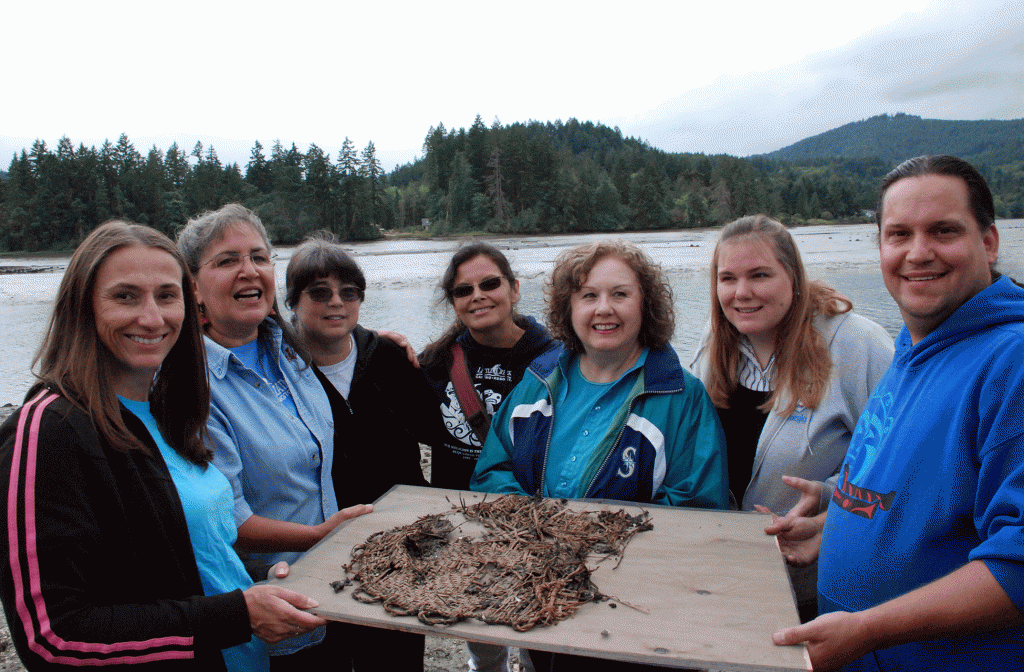The gifts from our ancestors mean so much!
Gathering Place
This cedar bough basket was one of several recovered from an ancient Squi-Aitl aquatic resources processing site near the head of Eld Inlet.
The Squi-Aitl people also occupied numerous other major villages and camps throughout the entire Eld Inlet watershed.
The lives of the Squi-Aitl people centered around the rich resources of the sea. One or more longhouses may have been located nearby, close to the water’s edge on the flat, grassy field where canoes could be easily beached. The site was also near the mouth of a stream, where fresh water flows into the salt water. This provided the people with more than one way to fish. This site was used for processing salmon, clams and oysters which were also highly prized trade goods. Tools that have been found include a vast array of stone, bone, wood and fiber implements, such as weirs, nets, baskets, arrows, spears and weights, etc. Most of these tools were designed to ease the daily tasks of fishing, gathering shellfish and processing their catches.
Standing near the shoreline perfumed by a salty, forest-scented fog, looking across the tidelands and marshes to the small cove peppered by remnants of an ancient fish weir, you can sense the presence of our ancestors who remain an integral part of this environment.
Waterlogged archaeological sites are called “wet sites.” These sites provide excellent preservation of wooden and fibrous artifacts because water is present all the time, keeping oxygen from reaching the artifacts. Organisms that cause decay, such as bacteria and fungus, cannot survive without oxygen. Therefore wooden and fibrous artifacts can be preserved for thousands of years in a wet site.
A Northwest Coast wet site can include a large number of artifacts because approximately 90% of things produced by Northwest people were made of wood or fiber. These artifacts may include planks from longhouses, foundation posts, house posts, canoes, clothing, woven mats, wooden boxes, baskets, nets, rope, eating utensils and much, much more. In non-waterlogged sites, these types of priceless artifacts are lost to decomposition.
A good clue that you are at a wet site is gray/blue-colored silt and clay soils. In waterlogged soils, the iron mineral has not oxidized or “rusted” which creates the common brown to reddish color of most soil. Also, on the Northwest Coast, these sites usually are on a slope, where water flows through the ground, keeping the site area waterlogged. Northwest soils are often acidic, so hair, hides, skin and other soft animal matter do not preserve in these wet sites.
Excavation in wet sites requires specialized archaeological equipment. Traditional shovels and trowels cannot be used because metal tools would cut right through the wood and fiber. Instead, water from fine-adjust hose nozzles and water pumps works best to delicately uncover these perishable artifacts. This system also works well for uncovering stone, bone and shell artifacts. Screening of the excavated material is best done by running water over the excavated material on screens, ensuring that artifacts can be easily seen and recovered without being damaged.
Once wooden and fibrous artifacts are removed, they must be soaked for extended periods of time in a special preservative called Carbo-wax (polyethylene glycol), a chemical that drives the water out and replaces it in the cell structure of waterlogged materials. If the artifacts such as baskets or nets were simply allowed to dry out, they would shrink, crack and eventually disintegrate.
Cultural items recovered from the Mud Bay site are on display at our beautiful museum, including a very rare cedar bark gillnet. Only two other sites have been discovered along the entire Northwest Coast that have cedar bark gillnets.
But these are only some of our rare gifts! Visit our Home of Sacred Belongings and discover our very rich history!

